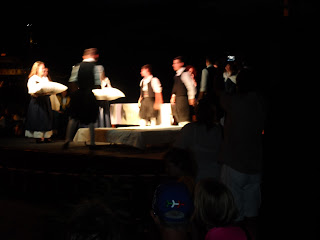Taking a break from the idyllic farm life in Santa Fiora, we decided to take our own little pilgrimage to the ancient town of Assisi, remembered for its breathtakingly beautiful architecture, and forever linked with St. Francis, one of the patron saints of Italy. As we drove through the Tuscan countryside, the skies lowered and looked ever more threatening as we neared our destination, and we feared our visit might be a short, wet one. The winding roads and sharp cutbacks on the mountains did not agree with Melissa's stomach, so when we arrived, I went out in the rain to find some food and drink that we could all relax with before planning our evening. Fortified and recuperated, Lorraine and I went off on discovery while Miss had a short rest.
The town is the destination of many pilgrimages and there were no shortage of nuns, priests and novitiates in every piazza and alleyway. The cobbled streets thrummed with the sound of guitars and young voices paying homage to the gentle saint who founded the Franciscan Order. St. Francis was a lover of nature and frescoes of him preaching to the birds adorn many walls.
Unfortunately, Assisi was hit by two major earthquakes that wreaked damage on the beautiful town in 1997. A heroic restoration allowed the Basilica di San Francesco, St. Francis' namesake and the major attraction, to reopen in 1999 and it was designated a World Heritage Site in 2000. Lorraine and I marvelled at the two medieval castles. The larger, called Rocca Maggiore, (1367), was truly intimidating. Every corner seemed to unveil another beautiful surprise: The Temple of Minerva, the Roman amphitheatre built in the early 1st century AD, the Piazza del Comune ("Communal Square"), with the Palazzo del Capitano del Popolo (mid-13th century), and The abbey of St. Benedict, founded in the 10th century on the Monte Subasio.
That night, we all strolled through the town and sat at a cafe to people-watch. Lorraine had a glass of wine and Melissa and I had a Peroni – one of the national beers. Our bill was placed discreetly on the table, but, enjoying ourselves as we were, we decided to have another round before dinner, and our bill magically multiplied and the price per drink had increased! Not just the new drinks, but the ones we had before! It was quite a challenge to my uncultured Italian to argue for this to be corrected, but, I am proud to say, we won the day and paid the old bill.
That night we found a quaint old restaurant in a tiny alleyway lit by candles placed at the side of the street. The outdoor tables took up most of the room in the alley, and we began to enjoy our antipasto, followed by a lamb pasta, a breast of hen, and spaghetti carbonara, accompanied by a delicious, and inexpensive vino da casa. We were just commenting on how quiet and rustic the street was when a car started down the alley. We laughed and mocked the driver thinking he was actually going to make it, when he started his own demolition derby drive. People stood up, flattened themselves against the walls and watched as his mirrors attempted to clear the tables of any outstanding wine bottles or glasses, and then he was through, literally scraping both mirrors on each side of the alley!
The next day we all made the very energetic hike through the town to the Basilica of San Francesco d'Assisi (St. Francis). The Franciscan monastery, il Sacro Convento, and the lower and upper church of St Francis were begun in 1228, after his canonization and completed in 1253. We were not too tired to appreciate the incredible architecture and stained glass that paid homage to the much beloved saint. Be forewarned that, as in the Vatican, men and women must have their shoulders covered – no tank tops. We were able to get a coverup for Melissa so that she could enjoy the experience, otherwise, she would have had to stay outside.
 |
| View from the Main Piazza |
 |
| Tuscan Countryside fron Assisi |
 |
| The Square where we had our pre-dinner cocktails. |
 |
| Can you Believe a Car Drove Down this Alley??? |
 |
| Basilica of San Francesco d'Assisi (St. Francis). |























